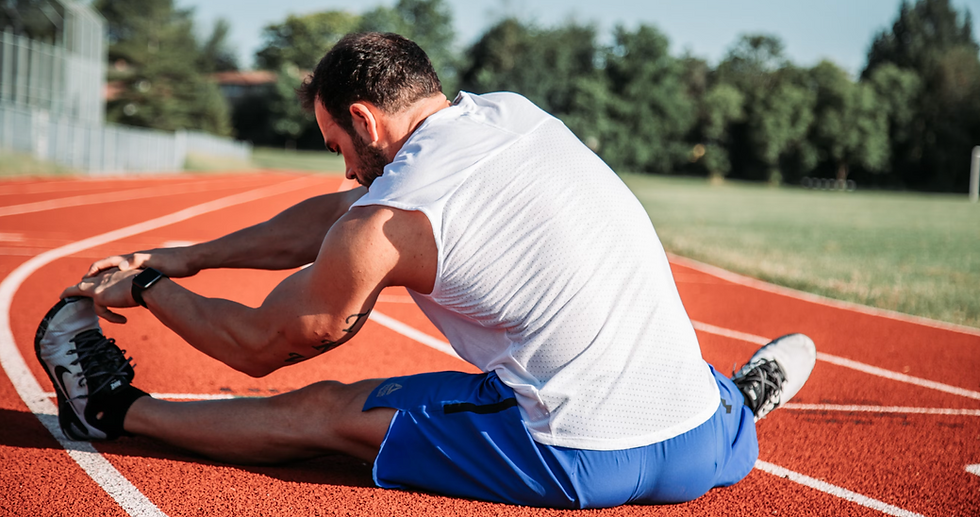Stretch Your Way to Strength: How Static Stretching Compares to Weight Lifting
- Barbara Johnson, MD
- Jun 20, 2024
- 6 min read
In the ever-evolving world of fitness, new research continually challenges our understanding of effective muscle-building techniques. One recent study has sparked significant interest by suggesting that static stretching, a commonly overlooked practice, might be as effective as lifting weights for building muscle.
This revelation could revolutionize how we approach strength training. Let’s delve into the science behind static stretching and how it might help you achieve your muscle-building goals.

The Science Behind Static Stretching for Muscle Growth
A groundbreaking study published in the European Journal of Applied Physiology examined the effects of static stretching on muscle growth and strength. Researchers divided participants into two groups: one performing static stretches for the hamstrings and the other engaging in traditional resistance training. Surprisingly, the results demonstrated significant increases in strength, muscle thickness, and flexibility for both groups. There was no significant difference between the two groups, leading researchers to conclude that static stretching could be as effective as resistance training in gaining strength and size.
The study specifically focused on the intensity and duration of the stretches. Participants in the stretching group held their stretches for 30 seconds to 2 minutes, which placed sustained tension on the muscle fibers. This prolonged tension led to muscle stress and microtears, similar to the effects of weight lifting. Moreover, when you apply tension to muscles and connective tissue (as you do in weight lifting and stretching) it activates proteins called integrins, which begin the process that leads to protein synthesis. And, it's during protein synthesis that muscles get bigger and stronger. During the recovery phase, these microtears are repaired, resulting in increased muscle mass and strength.
What's more, the stretching group showed a notable increase in flexibility compared to the lifting group. This improvement in flexibility can have additional benefits for overall physical performance and injury prevention. The researchers emphasized that it wasn't just the act of stretching, but the intensity of the stretch, that played a crucial role in muscle development. Light chest band work, for example, isn't going to get your pecs like The Rock, but more intense and sustained stretching can yield significant results.
While the study provides compelling evidence for the effectiveness of static stretching, it also acknowledges practical limitations. These include the need for specialized stretching devices and potential time constraints. Sitting in a stretch for 15 minutes isn't time-effective or enjoyable for most people. However, the results are promising, and further research is needed to explore the underlying mechanisms and address these limitations.
More Benefits of Static Stretching
Stretching is often seen as a warm-up or cool-down activity, but its benefits extend far beyond just flexibility. According to Dr. Behm, a renowned expert in the field, most people overlook the cardiovascular advantages of stretching, and these benefits are substantial.
Firstly, poor flexibility isn't just about tight muscles; it can also indicate restricted blood flow. Studies have linked limited flexibility to arterial stiffness, suggesting that if your body doesn't move well, your blood might not flow well either. Engaging in regular stretching can improve arterial function, reduce resting heart rate and blood pressure, and increase vasodilation, all of which are key components of cardiovascular health.
Moreover, mobility improvements can indirectly enhance cardiovascular health. Dr. Behm highlights that studies have shown runners become more efficient when they're more flexible. This efficiency leads to increased movement, which ultimately improves overall fitness levels. For non-athletes, flexibility plays a crucial role in injury prevention by enhancing balance. Better balance not only reduces the risk of falling but also mitigates the severity of injuries if a fall does occur.
Another critical benefit of stretching is improved athletic performance. While research on the direct impact of stretching on performance is mixed, Joe Yoon, a sports massage therapist, emphasizes the importance of range of motion. Being able to achieve the necessary positions for your sport can enhance performance and reduce the risk of injury. However, it's essential to approach stretching correctly. Studies have indicated that prolonged static stretching or immediate performance testing after stretching can lead to temporary decreases in strength, power, or speed. To avoid this, Dr. Behm suggests keeping stretches under 60 seconds per muscle and combining static stretches with active warm-up exercises.
In addition to enhancing performance, stretching can also reduce the risk of injuries. Dr. Behm explains that stretching helps identify areas of muscle vulnerability, where injuries are most likely to occur. Increased flexibility in these areas allows muscles to generate force safely at longer lengths, reducing the risk of injuries during explosive movements or sudden changes in direction.
Here are some further benefits of static stretching:
Muscle Growth: The study highlights that static stretching can significantly boost muscle size. This makes it an effective and low-impact method for building muscle mass. By holding stretches for longer periods, you can induce the same kind of muscle stress that weight lifting achieves, promoting muscle growth during the recovery phase.
Improved Flexibility: Static stretching is known for enhancing flexibility. This increased range of motion can contribute to better overall performance in various physical activities and reduce the risk of injuries. Improved flexibility allows muscles to work more efficiently and can prevent strains and other injuries related to tight muscles.
Joint Health: By improving the flexibility and strength of muscles surrounding the joints, static stretching can contribute to better joint stability and health. This can be particularly beneficial for individuals with joint pain or stiffness, as increased flexibility can reduce stress on the joints.
Convenience: Static stretching requires minimal equipment and can be performed almost anywhere, making it a convenient option for those with limited access to gym facilities. You can incorporate static stretches into your daily routine, whether at home, in the office, or on the go, without the need for specialized equipment.
Stress Relief: Stretching can be a relaxing activity that helps reduce stress and tension. By focusing on deep, slow stretches, you can calm your mind and body, promoting overall well-being.
Posture Improvement: Regular static stretching can improve posture by lengthening tight muscles that pull areas of the body away from their intended position. Better posture can lead to reduced pain and improved function.
How to Incorporate Static Stretching into Your Routine
Incorporating static stretching into your workout regimen can be simple and highly effective. Here are some practical tips to get you started:
Dedicate Time to Stretching: Allocate specific times during your workout for static stretching. This can be during your warm-up, cool-down, or as a standalone session.
Hold Stretches Longer: For muscle growth, hold each static stretch for at least 30 seconds, gradually increasing the duration as your flexibility improves.
Combine with Resistance Training: Use static stretching as a complementary technique alongside your regular strength training exercises. This combination can enhance overall muscle development and flexibility.
Focus on Major Muscle Groups: Ensure you stretch all major muscle groups to promote balanced muscle growth and flexibility throughout your body.
Example Static Stretching Exercises
Here are some of our favorite static stretches:
Hamstring Stretch: Sit on the floor with one leg extended and the other bent. Reach towards the toes of the extended leg and hold the stretch.
Calf Stretch: Stand facing a wall with one foot in front of the other. Press your back heel into the ground while keeping your leg straight and hold the stretch.
Quadriceps Stretch: Stand on one leg, pulling the opposite foot towards your glutes with your hand. Hold the stretch while keeping your knees close together.
Chest Stretch: Stand facing a corner or doorway with your arms extended to the sides, elbows bent at 90 degrees. Place your forearms on the walls and gently lean forward to stretch your chest muscles.
Shoulder Stretch: Bring one arm across your body and hold it with the opposite hand. Gently pull the arm towards your chest to stretch the shoulder.
Triceps Stretch: Raise one arm overhead and bend the elbow so your hand reaches down your back. Use the opposite hand to gently push the elbow downward to stretch the triceps.
Hip Flexor Stretch: Kneel on one knee with the other foot in front, forming a 90-degree angle. Push your hips forward while keeping your back straight to stretch the hip flexors.
Butterfly Stretch: Sit on the floor with your feet together and knees bent out to the sides. Hold your feet with your hands and gently press your knees toward the ground to stretch the inner thighs.
Back Stretch: Sit on the floor with your legs extended. Reach forward and try to touch your toes, keeping your back straight to stretch the lower back.
Static stretching, traditionally viewed as a flexibility-enhancing practice, is emerging as a powerful tool for muscle building. Imagine achieving the same muscle growth and strength gains as lifting weights, but with the added benefits of improved flexibility and joint health. The recent study suggests that integrating static stretching into your fitness routine can unlock new levels of performance and efficiency.
Whether you're an athlete looking to enhance your game or someone seeking a low-impact way to build muscle, static stretching offers a versatile and accessible solution. Embrace this innovative approach, stretch your limits, and transform your workouts for better results. The path to stronger, more flexible muscles might just be a stretch away. For more information, click here to contact us or call 276-235-3205 to schedule your complimentary discovery call.
The Johnson Center for Health services patients in-person in our Blacksburg and Virginia Beach / Norfolk locations. We also offer telemedicine for residents of Virginia and North Carolina!
.png)











































Comentarios